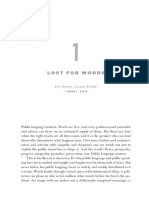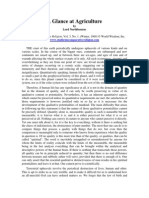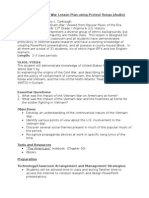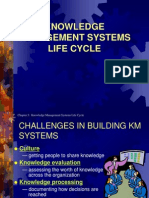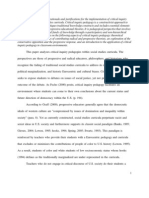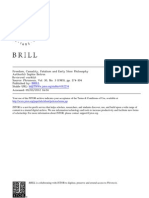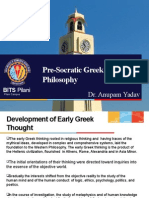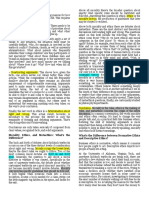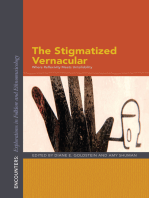Competing Memes Analysis
Competing Memes Analysis
Uploaded by
Millicent Anne BarrettoCopyright:
Available Formats
Competing Memes Analysis
Competing Memes Analysis
Uploaded by
Millicent Anne BarrettoCopyright
Available Formats
Share this document
Did you find this document useful?
Is this content inappropriate?
Copyright:
Available Formats
Competing Memes Analysis
Competing Memes Analysis
Uploaded by
Millicent Anne BarrettoCopyright:
Available Formats
3/31/12
Competing Memes Anal sis
Dirlam, D. K. (2003). Competing Memes Analysis. Journal of Memetics - Evolutionary Models of Information Transmission, 7.
ht:/fmogjmei/03 o7dra_khm tp/cp.r/o-mt20/ l/ilmd.tl
Competing Memes Anal sis
David K. Dirlam
414 Whitaker Street Savannah, GA 31401 USA. dirlamd@bellsouth.net Abstract 1. The challenge to memetics 1.1 General and specific memetics 1.2 Edmonds First Challenge: The Case Study 1.3. Edmonds Second Challenge: The falsifiable theory of when to use memetics 2. Competing Memes Analysis 2.1. Creating multidimensional classifiers from successions of memes 2.2. Collecting and coding records 2.3. Modedtng frequency changes over time or space Appendix A: Memetic system for the historical development of developmental research. Appendix B: Lotka-Volterra competition References Acknowledgments
Abstract
Aunger (2000) and Edmonds (2002) argue that memetics is a theory without a methodology, in imminent danger of dying from lack of novel interpretations and empirical work. Edmonds challenges memeticists to conduct empirical tests. This article presents Competing Memes Analysis, an empirical methodology that can readily be applied to significant social problems. The methodology is implemented in three steps. Step 1 identifies the organization of memes within an activity. Each activity is assumed to exhibit numerous small groups of memes where each meme within a group competes with all other memes in the group and can be combined with any meme from any other group. The succession of memes that occurs with increasing experience can be a powerful clue to identifying competing memes. Step 2 collects records of activities and codes them for the presence or absence of each meme identified in Step 1. Any activity that people acquire from each other by imitation can be readily coded for the presence or absence of competing
cfpm.org/jom-emit/2003/vol7/dirlam_dk.html 1/11
3/31/12
Competing Memes Anal sis
memes. Step 3 analyzes changing frequencies of each coded meme over time or space. Models of these changes can give useful clues to suggest empirical studies that will provide important social and scientific results. Ecologys Lotka-Volterra model of competing species illustrates the usefulness to memetics of population models. Keywords: memetic methodology, meme, drawing, writing, scientific research, Lotka-Volterra, competition
1. The challenge to memetics
Aunger (2000) contains several arguments that memetics is a theory without a methodology. He concludes (p. 230) "The ultimate testwhich would preempt theoretical objectionsis whether memetics can produce novel empirical work or insightful interpretations of previous results. It has not yet done so, but must do so in the near future. Otherwise, it is likely that memetics will be perceived to be a misguided enterprise. The clock is ticking." Edmonds (2002) extends Aungers argument by specifying three challenges for memetics. His first challenge is for a conclusive case study which shows a cultural process that (a) exhibits faithful replication where the replication process is transferred to many sources and (b) passes through a large enough quantity of such transfers to show adaptation resulting from verifiable advantages and consistent with current population-genetics models. He suggests nursery rhymes and legal phrases as appropriate test cases. Edmonds second challenge is for a falsifiable theory that identifies when a memetics interpretation is appropriate and necessary. Edmonds third challenge is for a credible simulation of an emergent (not "designed in") memetic process, analogous to "exhibiting a simulation of the emergence of life from the interaction of chemicals." This paper describes methodological techniques for meeting Edmonds case-study and memetics-interpretation challenges. Before describing the methodology it would be helpful to clarify a few aspects of the memetics challenge.
1.1 General and specific memetics
A significant source of potential confusion about memetics resembles the confusion within scientific history that occurred with Kuhns (1969) initial conception of "paradigm." A paradigm referred both to (a) "the entire constellation of beliefs, values, techniques and so on shared by members of a given community" and also to (b) "the concrete puzzle-solutions whichreplace explicit rules as a basis for the solution of the remaining puzzles of normal science." Note that the second, specific conception enables the former general conception and thus is the deeper of the two. Similarly, memetics is used in both a general and a specific manner. Specifically, we have the model of actions or artifacts that can be imitated with fidelity, fecundity and durability. Generally, we have the conception of memes as actions or artifacts that evolve independently of the people producing them. The specific conception enables the general one and is the deeper. But just like there are a host of biological studies that rely on but do not discuss evolutionary processes, there are also a host of possible memetics studies that rely on but do not discuss evolutionary processes. Furthermore, the methods used in general memetics studies may be directly applicable to
cfpm.org/jom-emit/2003/vol7/dirlam_dk.html 2/11
3/31/12
Competing Memes Anal sis
the fundamental questions raised within the specific conception. This occurs especially when studies have a methodological rather than a theoretical focus. Thus, a vast array of ecological, geological and genetic models depends on genetic evolution without addressing it and many mathematical models in these fields preceded evolutionary models by decades. The power of evolutionary thinking was due as much to the remarkable convergence of knowledge that supported it as to its own models. It seems likely that a future principle of the memetics of science will be that converging knowledge is a necessary predecessor to the dominance of any scientific system.
1.2 Edmonds First Challenge: The Case Study
Critical to Edmonds argument is that passing his challenges would show the "usability" of memetics. Edmonds suggestion of nursery rhymes and legal phrases as apt test cases was based on the assumption that the examples were "of a limited nature about which good quality data is available." More ambitious studies would not be believed until such "straightforward" examples had been established. Case studies are certainly essential, but Edmonds suggested topics can be improved. Unambitious content by no means guarantees straightforward conduct and interpretation of any study. The failure of attempts to program translation, transcription, and even textual search belie the straightforwardness of any natural language task. Especially at this early point in memetics research, the methodology and interpretation of all studies will be questioned. The critical factor for the future of memetics is not straightforward conduct and interpretation. Rather, the critical factor is whether the questions lead the scientific community to ignore or use and debate the results. The potential for use and debate, rather than obscurity, varies directly with the authors skill, the authors community support and the significance of the topic. Furthermore, the dynamics of the transmission of memes will be affected by the importance of the topic. Observing natural memetic transmission and adaptation is likely to be far more difficult for small niche topics, like those Edmonds suggested, than for topics that have more urgent and widespread social content. A primary goal of this paper is to show that although the quick-fix case study does not exist, there are methods that make the consequential studies no more difficult than those with minimal importance.
1.3 Edmonds Second Challenge: The falsifiable theory of when to use memetics
In his challenge for a falsifiable theory of when to use memetics, Edmonds rightly argues for a biological advantage of large brains independent to the hosting of memes. The issue of deciding when to apply memetics arguments, however, might be better conceived as methodological than theoretical. Though a theory might be easier to apply to ongoing social change, researchers would benefit more from operational definitions. Once several operational definitions have become established, the common elements would point to the needed theory. The ideal, operational definition would involve direct observation of imitation. Short of that ideal, indirect studies could use situations involving developmental or historical change that (a) minimize the influence of intra-individual processes and (b) allow for a high level of opportunity for imitation. One way of precluding intra-individual processes is to study only a single record per person. A high level of opportunity for imitation occurs by examining situations that contain a high probability of frequent contact between persons being studied.
cfpm.org/jom-emit/2003/vol7/dirlam_dk.html
3/11
3/31/12
Competing Memes Anal sis
2. Competing Memes Analysis
Competing Memes Analysis is a method that makes studies of consequential topics no more difficult than those with minimal importance. It is a three step process that (1) organizes activities into groups of competing memes that often emerge in developmental successions, (2) codes records of activities for the presence or absence of each meme, and (3) constructs models of the changing frequencies of the memes. The methodology has been constructed through studies of the ontogenetic development of drawing (Dirlam, 1996, contains a preliminary analysis), writing (Dirlam, 1982), and the historical development of research methods in developmental psychology (Dirlam, Gamble, and Lloyd, 1999). The purpose of the drawing and writing studies was to design objective pedagogical alternatives to educational testing that could be used with natural products of classroom activities. The purpose of the study of research methods was to determine whether the analytical models that fit the ontogeny of drawing and writing also fit historical development.
2.1. Creating multidimensional classifiers from successions of memes
The first step in the Competing Memes Analysis of an activity is to create multidimensional classifiers of competing memes (Dirlam, 1980). Each activity is assumed to exhibit numerous small groups of memes each of which comprises a dimension. A group of memes is a dimension when each meme within the group competes with all other memes in it and can be combined with any meme from any other group (see Appendix A for an example). The succession of memes that occurs with increasing experience can be a powerful clue to identifying competing groups. A memetic classifier for an activity consists of several dimensions of memes. Memetic classifiers can be readily constructed by anyone with modest expertise in a topic. A straight forward approach is to observe differences between people performing the activity who have various levels of experience. When one approach to the activity is commonly replaced by another, the two approaches are competing memes. Sometimes the later appearing memes contain earlier appearing ones. In any case, since the memes can be defined to be mutually exclusive, each succession becomes a dimension. Dimensions can and should be defined as exhaustive by generalizing to includeall other cases in the definition of one meme within each dimension. Thus, every record of an activity being investigated is assigned to one meme within each group of competing memes. When an emerging meme becomes frequent enough to separate from a generalized meme, it will be necessary to redefine and recode the dimension. Analysis of large collections of records might also reveal that some memes are so rare that they should be logically combined with others. Experts in an activity can help to construct definitions of each meme so that coders can reliably distinguish which is being used. For most important activities, there is theoretical literature that suggests a rich variety of memes. For example, more than half of the dimensions of competing memes used in the study of developmental research methods mentioned above were based on concepts from Danziger (1990). The memetic classifier for the study is presented in Appendix A. The study involved coding 912 articles written from 1930 to 1992 for the presence or absence of each meme in the classifier.
cfpm.org/jom-emit/2003/vol7/dirlam_dk.html 4/11
3/31/12
Competing Memes Anal sis
The number of dimensions in a competing memes analysis is a matter of researcher choice and depends on the state of knowledge in the subject at the time of the study. It should be noted, however, that gathering and examining records is usually much harder than coding them. Therefore, studies with several dimensions require considerably less resources per dimension than single-dimension studies. The memes themselves are like fractals they can apply to content as fine-grained as words, lines and study locations or as general as complete discourses, complete drawings and complete research articles.
2.2. Collecting and coding records
The second step in Competing Memes Analysis is to systematically collect and code records of memes. In order to permit the construction of testable models, the records should be drawn from a corpus that contains a meaningful point in time or space for all samples. For example, time points for the studies of drawing and writing were the age of each participant and time points for the developmental research study were the publication years of the articles. Studying the spread of memes from their spatial points of origin should also generate rich, useful results. Drawings are self-contained records of the actions of those who made them. Similarly, writing samples record the actions of writers and research reports record the actions of researchers. Audio and video tapes are also records of memetic activity. Because memes are imitated, any user of a meme and many non-users can identify uses of it by others. This means that discrete samples can be reliably coded for the presence or absence of a meme. If a ten-dimensional system has been defined (as in section 2.1 above), each record will contain ten memes. One clear implication of memetics is that humans are uniquely capable of identifying memes. The only rival species, apes and parrots, are readily surpassed in speed, variety and complexity of imitation by preschool children. Examining the diversity of memes in the three studies that have used Competing Memes Analysis reveals that the complexity or importance of memes did not affect our ability to identify them. Hence, consequential studies are no more difficult than those with minimal importance.
2.3. Modeling frequency changes over time or space
Once records have been coded, it is possible to count the uses of memes in situations with important consequences, whether they be economic (e.g., the use of a new product), social (e.g., the spread of juvenile crime), political (e.g., the repetition of a candidates message), educational (e.g., the way students and programs are evaluated) or scientific (e.g., the spread of a methodology). For example in the study of developmental research methods, the model projected that the growth of difference statistics was so fast that if a competitor did not emerge in the next few decades, data analysis would consume so much of available resources (i.e. social acceptance) that it would implode (see Figure 1). During the 1930-1992 study period, data modeling was too rare to analyze separately from difference statistics. But since it is a valued and slow-growing alternative, it is a possible solution to the collapse of the analysis dimension.
cfpm.org/jom-emit/2003/vol7/dirlam_dk.html
5/11
3/31/12
Competing Memes Anal sis
Figure 1. Best fitting Lotka-Volterra model for competing data analysis memes. Memetics skeptics would most readily accept studies that operationally define their memetic nature by setting up situations for observing imitation. However, imitation can be inferred rather than directly observed, and can be interpreted broadly as reproduction. This opens up the potential to use archival data (e.g. research reports, crime incident reports, corporate audits and so forth). A dramatic memetics success would occur if memes were discovered that effectively competed with such practices as crime among low income juveniles, self and community destructiveness among religious fundamentalists and fraud among corporate CEOs faced with poor results. Key evidence for successful competition would come from changing frequencies of memes over time or space. Beyond identifying memes, Competing Memes Analysis may involve a search for (1) the path of succession from one meme to the next, (2) the resources required, (3) the growth rate and (4) the competitive strength of such practices. Results of these types of studies may help us to understand such issues as (a) how memes that are seen as "weeds" contribute to general survival and (b) how the harmful effects of overgrowth of such memes can be controlled. An example of (a) would be marketing processes that make it possible to establish products in extremely competitive markets, but permit monopoly-like overgrowth in noncompetitive markets. Examples of(b)would be finding competitors to the emergence of monopolies ranging from antitrust laws to innovations that disrupt them. The problems solved while undertaking a rich variety of such studies could provide the sort of clarity needed to meet Edmonds challenge for a falsifiable theory of when to use memetics. Definitive answers to questions about resources, growth rate and competitive strength may be difficult to obtain without detailed experimental studies. However, once hundreds of records of memes have been systematically
cfpm.org/jom-emit/2003/vol7/dirlam_dk.html 6/11
3/31/12
Competing Memes Anal sis
collected from a population, placed within a meaningful distribution of time or space, coded and counted, it is possible to develop models of the frequency changes. Such models can reveal characteristics of memes that are difficult to observe directly. They also make detailed, testable predictions. A model that influenced the competing memes analysis, proposed here, is the Lotka-Volterra model of species competition (see Appendix B). This model describes the population of species that compete within an ecosystem as depending on four parameters: the initial population, the maximum sustainable population, the growth rate, and the competitive strength. Given these parameter values, at least four life cycles of memes can be identified (see Appendix A). Rapid growth rate is high enough to create chaotic fluctuations in a noncompetitive environment. Data analysis modeled in Figure 1 is an example. High competitive strength reduces the rapid growth of competitors to moderate levels or less. Life c cles Default Niche Pioneering Dominant Parameter values Initial prevalence High Low Low Low Growth rate Near zero Slow Rapid Moderate Competitive strength Near zero High Low High
Table 1. Lotka-Volterra values for four memetic life cycles. Once such vital statistics of a group of memes have been worked out, scientifically significant and socially valuable experiments can be conducted to determine the factors that influence the long-term vitality of particular memes. For example, revisiting the species analogy, we note that pioneering species are often those that adapt to the presence of many predators by growing very rapidly. If such species find an environment where the predators are absent, their populations can grow so rapidly that they consume too much for the environment to sustain them. The formerly adaptive high growth results in a local extinction. It takes little imagination to realize what powerful social consequences would occur when the analogous process operates mimetically. Pioneering growth may be as essential to responding to social threats or establishing new products as it is to establish species in predatory environments. But planners need to be aware of the social or economic danger that these new responses or products pose if their memetic competitors were to suddenly vanish. In conclusion, Competing Memes Analysis provides memetics with a method for conducting precise studies of memetic processes found in any human activity. It can be summarized as a 3 step process. Step 1identifies the organization of memes within an activity. Each activity is assumed to exhibit numerous small groups of memes where each meme within a group competes with all other memes in the group and can be combined with any meme from any other group. The succession of memes that occurs with increasing experience can be a powerful clue to identifying competing groups. Step 2 collects records of activities and codes them for the presence or absence of each meme identified in Step 1. Step 3 analyzes changing frequencies of each coded meme over time or space. Models of these changes can give useful clues to suggest empirical studies that will provide important social and scientific results.
cfpm.org/jom-emit/2003/vol7/dirlam_dk.html
7/11
3/31/12
Competing Memes Anal sis
Appendix A: Memetic system for the historical development of developmental research
DIMENSIONS Life cycles (see Table 1 for explanation of life cycles)
Default Limited Behaviors Easily counted, or Categorized Coded free behavior DATA ANALYSIS What kind of statistics were used? Niche Summed or Enumerated Standardized tests or sums of ratings of loosely connected items) Difference Statistics t-tests, ANOVAs non-parametric difference tests or modeling Longitudinal Repeated measurements taken years apart Pioneering Dominant Categorized and Other coded free behavior combined with a second dependent variable
DEPENDENT VARIABLES What was measured in the study?
Descriptive Statistics like counts, means or correlations Microlongitudinal Repeated measurements taken weeks apart Dependent Variable Using age as a measure of how long it takes to develop
DESIGNS How often were comparable measurements taken? AGE Was it used to measure time or to assign people to groups? SOCIAL CONTEXT Who was present with the people being studied? LOCATION Where was the study done?
cfpm.org/jom-emit/2003/vol7/dirlam_dk.html
One Session Per Task
Single Age Group
Multiple Age Groups
Significant Test Alone or With Other Alone or Experimenter With Test School, Home, Other, Lab, or Multiple
Unspecified
8/11
3/31/12
Competing Memes Anal sis
BACKGROUND How many fields used as sources? APPLICATIONS Who benefited from the study?
Interdisciplinary
Disciplinary Only one Others Professionals or individuals
Researchers Only
Table 2. The life-cycles and dimensions of a Competing Memes Analysis for developmental research methods.
Appendix B: Lotka-Volterra competition
Lotka (1925) and Volterra (1926) independently formulated competition between species in an ecosystem. The basic idea is an expansion of Verhulsts logistic law of a century earlier, which in turn built on Malthus concept of exponential growth, where the population at a particular moment in time equals the population at the preceding moment multiplied times one plus the growth rate. (1) x = x * (1+r) Populations do not grow beyond the available resources, but rather either stabilize at an equilibrium that depends on the resources or collapse after exhausting the resources. Letting k denote the equilibrium population, Verhulst corrected Malthus notion by reducing the growth rate as the population approached the equilibrium. (2) x = x * [1+ r*(1-x/k)] When the population x equals the equilibrium population k, the growth rate will be 0. The result for slow or moderate growth rates is the well known S-curve that reaches an asymptote at the equilibrium. Also, this is the equation that produces wild fluctuations with very high growth rates. Its age, simplicity and practical usefulness have made it a favorite of chaos theorists. Lotka and Volterra further refined Verhulsts equation by reasoning that a competing species would further reduce the growth rate. They argued that the effect of each competing species would depend on its population, y, multiplied by a characteristic competitive strength factor, c. Of course, each competing species would reduce the population of the target species. (3) x = x * [1+ r*(1-x/k)] - ciyi Since, the model is commonly applied to discreet breeding cycles, it is easy to develop a spreadsheet program where the populations at a particular point of time are found in a single row and are used to calculate the populations in the successive moment in the following row. Further details of applying the model to developmental and historical data can be found in Dirlam, Gamble, and Lloyd (1999).
References
cfpm.org/jom-emit/2003/vol7/dirlam_dk.html 9/11
3/31/12
Competing Memes Anal sis
Aunger, R (2000). Conclusions. In R. Aunger (ed.), Darwinizing Culture: The Status of Memetics as a Science, Oxford, Oxford University Press, 205-232. Danziger, K. (1990). Constructing the Subject: Historical Origins of Psychological Research. Cambridge: Cambridge University Press. Dirlam, D. K. (1980). Classifiers and cognitive development. In S. & C. Modgil (Eds.), Toward a Theory of Psychological Development. Windsor, England: NFER Publishing, 465-498. Dirlam, D. K. (1982). Theoretical Framework. In NE NY Board of Cooperative Educational Services, The Second R. Bureau of English Education, New York State Educational Department. Dirlam, D. K. (1996). Macrodevelopmental analysis: From open fields to culture via genres of art and developmental research. Mind, Culture, and Activity, 3, 270-289. Dirlam, D. K., Gamble, K. L., & Lloyd, H. S. (1999). Modeling historical development: Fitting a competing practices system to coded archival data.Nonlinear Dynamics, Psychology, and Life Sciences, 3, 93-111. Edmonds, B. (2002). Three Challenges for the Survival of Memetics. Journal of Memetics - Evolutionary Models of Information Transmission, 6. http://cfpm.org/jom-emit/2002/vol6/edmonds_b_letter.html Kuhn, T. (1969) The Structure of Scientific Revolutions. Chicago: University of Chicago Press Lowenfeld, V. (1957). Creative and Mental Growth(3rd ed.). New York: Macmillan. Moffett, J. (1968). Teaching the Universe of Discourse. Boston: Houghton Mifflin. Piaget, J. & Inhelder, B. (1967). The Child's Conception of Space. New York: Norton.
Acknowledgments
Most of the integrating work for this paper was accomplished in 1997-1998 while I was a James McKeen Cattell Fellow at the Laboratory of Comparative Human Cognition of the University of California San Diego. I would like to thank Michael Cole for comments on earlier versions of this manuscript and for his extensive advice and counsel over the last seven years of this project. Kurt Danziger, James Moffett, and Jerry Balzano also provided important theoretical insights on the road to refining Competing Memes Analysis. The readability and usefulness of this article was greatly improved by the careful editorial commentary of Martin De Jong. Paul Marsden also offered numerous very useful suggestions. Especially, the treatment of pioneering growth was more balanced as a result of his involvement.
JoM-EMIT 2003
Back to Issue 2 Volume 7
cfpm.org/jom-emit/2003/vol7/dirlam_dk.html
10/11
3/31/12
Competing Memes Anal sis
cfpm.org/jom-emit/2003/vol7/dirlam_dk.html
11/11
You might also like
- 1.said OrientalismReconsideredDocument20 pages1.said OrientalismReconsideredAbdoukadirr SambouNo ratings yet
- Analyzing Oppression - Cudd, Ann E., 1959 - 2006 - New York - Oxford University Press - 9780195187434 - Anna's ArchiveDocument300 pagesAnalyzing Oppression - Cudd, Ann E., 1959 - 2006 - New York - Oxford University Press - 9780195187434 - Anna's Archiveratyanshgarg2005100% (1)
- Multiliteracies: How Readers Interpret Political Cartoons: Visual CommunicationDocument25 pagesMultiliteracies: How Readers Interpret Political Cartoons: Visual CommunicationIrwanSyahNo ratings yet
- Edwards - Irrelevance of Development Studies 1989Document21 pagesEdwards - Irrelevance of Development Studies 1989Letícia CesarinoNo ratings yet
- COMM 222 OutlineDocument8 pagesCOMM 222 OutlineMtlMtlcaqcNo ratings yet
- LayersOf HumanValuesInStrategyDocument8 pagesLayersOf HumanValuesInStrategylali62No ratings yet
- Memeology: An Ideological Psychoanalysis of How Memes Interact With Social Media ConsumersDocument14 pagesMemeology: An Ideological Psychoanalysis of How Memes Interact With Social Media ConsumersNguyen LongNo ratings yet
- Why Nations Fail - A Direction For A Comprehensive SynthesisDocument5 pagesWhy Nations Fail - A Direction For A Comprehensive SynthesisNeelesh MarikNo ratings yet
- Corrosive Consciousness - Bellamy FitzpatrickDocument10 pagesCorrosive Consciousness - Bellamy FitzpatrickviersiebenNo ratings yet
- A Memetic LexiconDocument9 pagesA Memetic Lexiconamurph1111No ratings yet
- Butters SpiraldynamicsDocument13 pagesButters Spiraldynamicsonlyanam100% (1)
- Chapter 1 - Enough Said PDFDocument20 pagesChapter 1 - Enough Said PDFwamu885No ratings yet
- Understanding Religion Spring 2018 SyllabusDocument6 pagesUnderstanding Religion Spring 2018 SyllabusstephenmkNo ratings yet
- Exploring White Supremacy On Social MediaDocument28 pagesExploring White Supremacy On Social MediaRyan BowmanNo ratings yet
- Introduction To FalsificationismDocument2 pagesIntroduction To FalsificationismKeith PisaniNo ratings yet
- Essay 4 Playlist ProjectDocument6 pagesEssay 4 Playlist Projectapi-498140910No ratings yet
- A Glance at Agriculture (Lord Northbourne) PDFDocument12 pagesA Glance at Agriculture (Lord Northbourne) PDFIsraelNo ratings yet
- Aimcat 24Document122 pagesAimcat 24vishwasNo ratings yet
- Compulsory MiseducationDocument65 pagesCompulsory Miseducationapi-3705112No ratings yet
- Emotional Content Bias in Urban LegendsDocument28 pagesEmotional Content Bias in Urban LegendsShisharka100No ratings yet
- Gerontology Chapter 1 IntroDocument9 pagesGerontology Chapter 1 IntroSJNo ratings yet
- Cynical Protest: Defining Bob Dylan's Tensely Symbiotic Relationship With The Folk Protest MovementDocument7 pagesCynical Protest: Defining Bob Dylan's Tensely Symbiotic Relationship With The Folk Protest MovementNicholas ShereikisNo ratings yet
- Making Our Way Through The World Human Reflexivity and Social Mobility by Margaret S ArcherDocument12 pagesMaking Our Way Through The World Human Reflexivity and Social Mobility by Margaret S ArcherghinaNo ratings yet
- Human Nature Syllabus 2018Document2 pagesHuman Nature Syllabus 2018曾兆崙No ratings yet
- 2008 - Agenda-Setting and Rhetorical Framing by Semantic ProximityDocument35 pages2008 - Agenda-Setting and Rhetorical Framing by Semantic ProximityLaura PereiraNo ratings yet
- Dusek Review Fuller Dissent On DescentDocument12 pagesDusek Review Fuller Dissent On DescentphgagnonNo ratings yet
- Tech Lesson (Audio) - Protest Songs VietnamDocument5 pagesTech Lesson (Audio) - Protest Songs Vietnammax'smom100% (1)
- Literature Review: IdeologyDocument11 pagesLiterature Review: IdeologyKyteNo ratings yet
- Signs and Values: For A Critique of Cognitive SemioticsDocument13 pagesSigns and Values: For A Critique of Cognitive SemioticsSaeed AbdeljaleelNo ratings yet
- Self DeceptionDocument24 pagesSelf Deceptionanon_140294019No ratings yet
- Theories of Social ChangeDocument16 pagesTheories of Social ChangeYaz VanityNo ratings yet
- Systems Thinking To Improve The Public's HealthDocument8 pagesSystems Thinking To Improve The Public's HealthValentina Esguerra MedinaNo ratings yet
- New Ontologies? Reflections On Some Recent Turns' in STS, Anthropology and PhilosophyDocument21 pagesNew Ontologies? Reflections On Some Recent Turns' in STS, Anthropology and Philosophypedro luisNo ratings yet
- Knowledge Management Systems Life CycleDocument33 pagesKnowledge Management Systems Life CyclePooja Prateek JoshiNo ratings yet
- Biosemiotics:: To Know, What Life KnowsDocument8 pagesBiosemiotics:: To Know, What Life Knowsbedevere86No ratings yet
- Social Mood, "Deep" History, and The Elliott Wave PrincipleDocument16 pagesSocial Mood, "Deep" History, and The Elliott Wave Principlefreemind3682No ratings yet
- Debating Humanity. Towards A Philosophical Sociology: Daniel CherniloDocument20 pagesDebating Humanity. Towards A Philosophical Sociology: Daniel CherniloEka Wahyudi NggoheleNo ratings yet
- Plato's Republic (Course Material)Document4 pagesPlato's Republic (Course Material)maxhkNo ratings yet
- Theories of CommunicationDocument15 pagesTheories of CommunicationalchemistNo ratings yet
- Incorporating Critical Inquiry Pedagogy in Social Studies CurriculumDocument27 pagesIncorporating Critical Inquiry Pedagogy in Social Studies Curriculumnbowling100% (7)
- Freedom, Causality, Fatalism and Early Stoic PhilosophyDocument32 pagesFreedom, Causality, Fatalism and Early Stoic PhilosophycaltrapsNo ratings yet
- Culture Networks PDFDocument73 pagesCulture Networks PDFPaco LunaNo ratings yet
- Nikolas Rose - Disorders Witouht BordersDocument21 pagesNikolas Rose - Disorders Witouht BordersPelículasVeladasNo ratings yet
- Feminist Studies, Inc. Feminist Studies: This Content Downloaded From 134.53.225.202 On Fri, 08 Jun 2018 04:43:37 UTCDocument27 pagesFeminist Studies, Inc. Feminist Studies: This Content Downloaded From 134.53.225.202 On Fri, 08 Jun 2018 04:43:37 UTCMatías DiezNo ratings yet
- Pre-Socratic Greek PhilosophyDocument11 pagesPre-Socratic Greek PhilosophyAdil Islam100% (1)
- A Systems Conception of PersonalityDocument40 pagesA Systems Conception of PersonalityDonNo ratings yet
- Emery y Trist (1965) - Causal Texture PDFDocument14 pagesEmery y Trist (1965) - Causal Texture PDFCORPORACION DENSEL SRLNo ratings yet
- Social Responsibility and Good GovernanceDocument20 pagesSocial Responsibility and Good GovernanceRosemarie Miano TrabucoNo ratings yet
- Music and PeaceDocument5 pagesMusic and PeaceAmy SNo ratings yet
- Paulo Freires Theory of EducationDocument41 pagesPaulo Freires Theory of EducationNina LisazuNo ratings yet
- Steps To Creating A Brighter FutureDocument36 pagesSteps To Creating A Brighter FutureMatthewNo ratings yet
- Image Is The MeasureDocument3 pagesImage Is The MeasureTerence BlakeNo ratings yet
- Agonistic Critiques of LiberalismDocument19 pagesAgonistic Critiques of LiberalismhimgilNo ratings yet
- Complexity in Evolution by Ken BaskinDocument26 pagesComplexity in Evolution by Ken BaskinNed FlandersNo ratings yet
- Idealism Realism: Philosophical TheoryDocument4 pagesIdealism Realism: Philosophical TheoryKristhel Pecolados Rombaoa100% (1)
- Socratic HumilityDocument5 pagesSocratic HumilitydinaticoNo ratings yet
- The Science of Investigation: Working with Equations -- Book 2, The Human Equation ToolkitFrom EverandThe Science of Investigation: Working with Equations -- Book 2, The Human Equation ToolkitNo ratings yet
- Know Thyself: Action and Perception -- Book 3, The Human Equation ToolkitFrom EverandKnow Thyself: Action and Perception -- Book 3, The Human Equation ToolkitNo ratings yet
- The Stigmatized Vernacular: Where Reflexivity Meets UntellabilityFrom EverandThe Stigmatized Vernacular: Where Reflexivity Meets UntellabilityDiane E. GoldsteinNo ratings yet
- How Small Social Systems Work: From Soccer Teams to Jazz Trios and FamiliesFrom EverandHow Small Social Systems Work: From Soccer Teams to Jazz Trios and FamiliesNo ratings yet
- The Fourth Industrial Revolution & 100 Years of AI (1950-2050)From EverandThe Fourth Industrial Revolution & 100 Years of AI (1950-2050)No ratings yet
- Kalua 2009Document11 pagesKalua 2009Paula BessaNo ratings yet
- People V MolinaDocument3 pagesPeople V MolinaJc IsidroNo ratings yet
- This Little CornerDocument17 pagesThis Little Cornerchim.chimNo ratings yet
- Cultural CompetenceDocument7 pagesCultural CompetenceRadoslav Baya CorlijaNo ratings yet
- Natural Law PhilippinesDocument1 pageNatural Law PhilippinesAnonymousNo ratings yet
- Scope of HRM: 1. The Labour or Personnel AspectDocument4 pagesScope of HRM: 1. The Labour or Personnel AspectHenrypat Uche OgbuduNo ratings yet
- Researce MethodsDocument11 pagesResearce MethodsasifufdNo ratings yet
- TIME - An Understanding From Bhagavad GitaDocument6 pagesTIME - An Understanding From Bhagavad GitaSowmya SathishNo ratings yet
- Descartes Handout The Rules and Maxims I PDFDocument1 pageDescartes Handout The Rules and Maxims I PDFAnonymous u80JzlozSDNo ratings yet
- The History of The Universe - Lyth (2016) PDFDocument123 pagesThe History of The Universe - Lyth (2016) PDFLuis Alonso SA100% (1)
- Novie RoseDocument24 pagesNovie RoseMark Andris GempisawNo ratings yet
- Rahul CVDocument2 pagesRahul CVRahul BarnwalNo ratings yet
- One Liner Tricks For Prelims (Part 1)Document12 pagesOne Liner Tricks For Prelims (Part 1)Anil SharmaNo ratings yet
- Data Collection and SamplingDocument16 pagesData Collection and SamplingDe Guia Novee MaeNo ratings yet
- The 'Key' or Clavis of Jacob BoehmeDocument36 pagesThe 'Key' or Clavis of Jacob BoehmePier Paolo Dal Monte100% (1)
- Tonight On Paranexus Universe Radio: Psychic Perspective: Helping Spirits During InvestigationsDocument5 pagesTonight On Paranexus Universe Radio: Psychic Perspective: Helping Spirits During InvestigationsParaNexus Anomalous Research AssociationNo ratings yet
- To Separate Centaur: On Relationship Archaeology History in Soviet TraditionDocument10 pagesTo Separate Centaur: On Relationship Archaeology History in Soviet Traditionşakir KarakoçNo ratings yet
- Eln Old Realm LessonsDocument14 pagesEln Old Realm LessonsBrand55No ratings yet
- HRM - High-Performance Work SystemsDocument8 pagesHRM - High-Performance Work Systemscons theNo ratings yet
- TLWDocument134 pagesTLWps0208No ratings yet
- Kami Export - Keira Timmins - John Locke Mini LessonDocument2 pagesKami Export - Keira Timmins - John Locke Mini LessonKeira TimminsNo ratings yet
- Personality & Consumer BehaviourDocument27 pagesPersonality & Consumer BehaviourArathy Vikram100% (1)
- The Seabury TowndanceDocument58 pagesThe Seabury TowndanceNathanNo ratings yet
- AdditionalDSUSMaterial CompleteDocument403 pagesAdditionalDSUSMaterial CompleteEyosyas Woldekidan100% (1)
- Interference of Light Waves PDFDocument29 pagesInterference of Light Waves PDFSGNo ratings yet
- Proclamation Announcement For The WORLD SERVICE AUTHORITYDocument4 pagesProclamation Announcement For The WORLD SERVICE AUTHORITY:Lawiy-Zodok:Shamu:-ElNo ratings yet
- Daily Lesson Log Tabio National High School Grade 8 Mae Ann R. Daganos ICT JUNE 3, 4 & 6, 2019 1-2 PM FirstDocument2 pagesDaily Lesson Log Tabio National High School Grade 8 Mae Ann R. Daganos ICT JUNE 3, 4 & 6, 2019 1-2 PM Firstrufina andresNo ratings yet
- Module 4 Deontology IDocument8 pagesModule 4 Deontology Ino.jam.teamNo ratings yet
- Ibn Sina AutobiographyDocument2 pagesIbn Sina AutobiographyAhmad AliNo ratings yet











